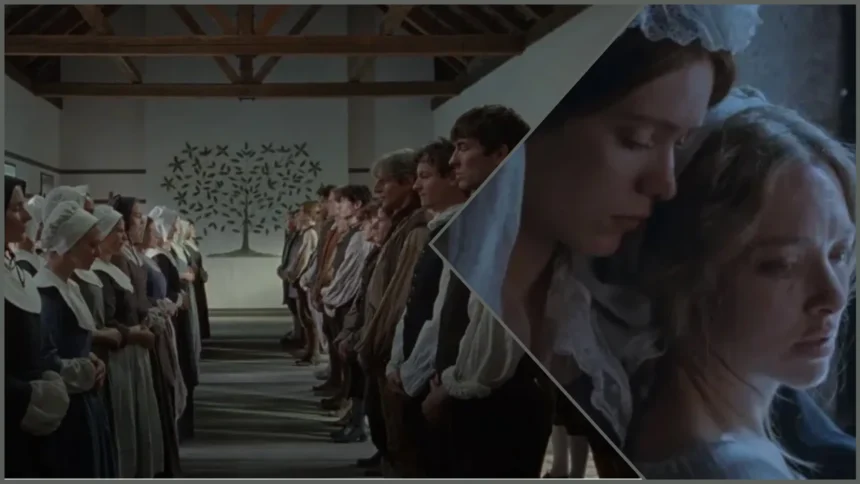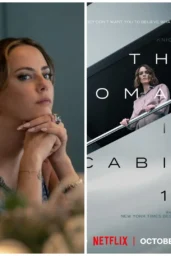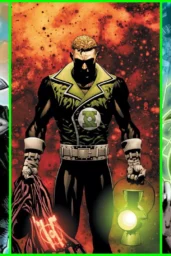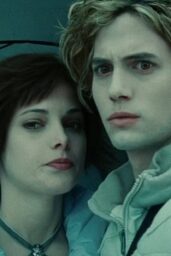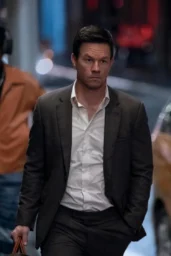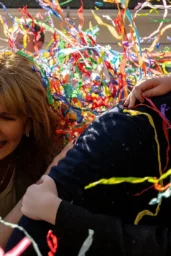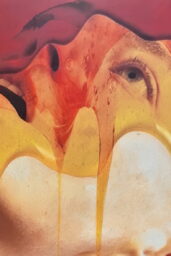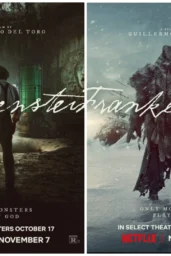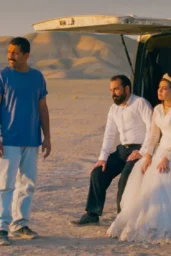Take that congregation scene. Rows of women in bonnets on one side, men in vests opposite, all fixed on a leafy tree mural like it's handing down judgment. It's got this rigid symmetry—framed wide to catch the barn-like hall's beams overhead, shadows pooling on the floor. The colors? Muted grays and browns, almost sucked dry, giving off an air of quiet intensity. Devotion, sure, but edged with something uneasy. Reminds me of those old Bergman setups, where the composition alone tells you the harmony's fragile.
Then there's the intimate one: two figures huddled by a window, frost biting the glass, snow blurring the outside world. One woman's face—likely Seyfried's Ann Lee—tilted down, veil framing her profile in soft lace, while the other gazes out, eyes distant. Blue tones dominate, chilling the frame, underscoring isolation. Loss hangs there, heavy. Yeah, it's period dress, but the emotional close-up feels modern, raw. Not your powdered-wig fluff.
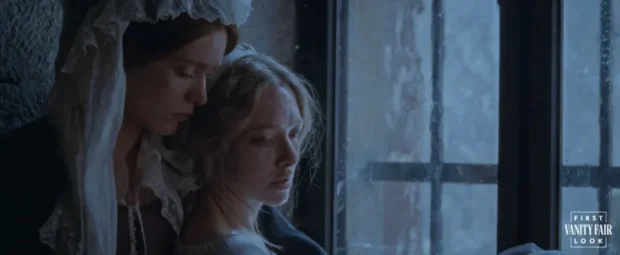
These first images, unveiled in Vanity Fair's exclusive peek, land just as Fastvold's latest heads to the Venice Film Festival for its world premiere on September 1, 2025. It'll bow in competition at Venezia 82, then hit Toronto on September 6. Still hunting for a distributor, but with this visual tease, it's already stirring curiosity in indie circles. Shot on 70mm over a brisk 34 days, budget scraping under $10 million—echoing what her partner Brady Corbet pulled off with “The Brutalist.” Storms raged, ships sailed, big set pieces unfolded, all on a shoestring. Resourceful doesn't cover it.
Set in 18th-century England, the 137-minute film's billed as an epic fable, loosely drawing from the real Ann Lee—the Shaker movement's founder, hailed by followers as the female Christ. She birthed four kids, lost them all young, then built a celibate utopia fueled by song and dance. Seyfried steps into that role, risking it all, backed by a solid ensemble: Thomasin McKenzie, Lewis Pullman, Christopher Abbott, Tim Blake Nelson, Stacy Martin. Rising talents mixed with vets—smart casting for a project this bold.
This is Fastvold's third go as director, after “The Sleepwalker” in 2014 and “The World to Come” in 2020. She's co-written all of Corbet's features too—”The Childhood of a Leader,” “Vox Lux,” “The Brutalist.” They've been at it over a decade, this pair, pushing indie boundaries without the big-studio safety net. Ambitious? Hell yes. I've seen partnerships fizzle, but theirs keeps delivering scale on scraps.
Don't know if it'll cohere into greatness—festivals chew up dreams like that. But these stills? They intrigue. The refusal to play safe, to let visuals whisper themes instead of shouting. It's got me thinking back to a late-night screening of “Days of Heaven,” that golden-hour magic on film stock. If Fastvold captures even half that essence on 70mm, we're in for something.
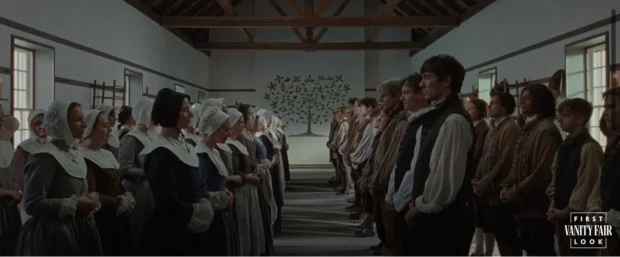
Frames That Linger: Insights from ‘The Testament of Ann Lee' Stills
Austere Symmetry in the Hall: The divided congregation shot captures Shaker order through balanced framing, subtly underscoring themes of separation and communal tension in a desaturated palette.
Chilled Intimacy at the Window: Blue-hued close-up of two women evokes personal grief and isolation, tying directly to Ann's losses while hinting at the film's emotional core.
Technical Boldness on Display: Shooting epic elements like storms on 70mm with a tight budget showcases resourceful filmmaking, mirroring indie trends toward grand visions without excess.
Ensemble Promise: Seyfried's lead role, surrounded by indie standouts, suggests layered performances in a story blending history with fable-like elements.
Festival Trajectory: Premiering soon at Venice and Toronto, the film's buzz positions it as a potential breakout in the awards circuit, still distributor-free.
What grabs you in these shots—the quiet menace, or the promise of song amid sorrow? Sound off in the comments, share if it sparks your interest, and keep an eye here for Venice updates.

